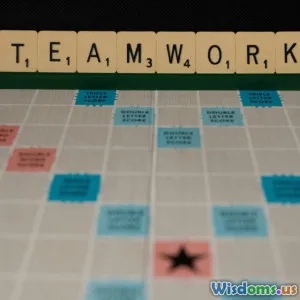
Transforming Conflict into Collaboration A Step by Step Guide
8 min read Master the art of turning conflicts into productive collaborations using a clear, practical guide. (0 Reviews)
Transforming Conflict into Collaboration: A Step-by-Step Guide
Conflict is often seen as a disruptive force, something to be avoided or suppressed—yet, when navigated thoughtfully, conflict can become a catalyst for collaboration and innovation. Organizations, teams, and individuals who master this transformation unlock unprecedented creativity and stronger relationships.
In this comprehensive guide, we’ll explore actionable steps to convert destructive conflicts into collaborative solutions. Backed by real-world research, practical examples, and expert insights, this resource empowers you to face conflicts head-on and turn differences into powerful teamwork opportunities.
Understanding Conflict: The First Step
Conflict arises naturally wherever people interact. Differences in values, priorities, goals, or communication styles can spark disagreements. According to the Harvard Negotiation Project, about 65% of workplace conflicts arise from misunderstanding and communication breakdowns rather than actual differences in interests.
But not all conflict is harmful. Conflict can serve as a signal for underlying issues that need resolution or an opportunity for fresh perspectives. The key is changing how we approach conflict—from confrontation to collaboration.
Insight: Douglas Stone, author of Difficult Conversations, describes conflict as "a handling of differing perceptions, rather than inherent 'right' or 'wrong.'"
Step 1: Transform Mindsets — From Opposition to Opportunity
Many adversarial conflicts stem from fixed mindsets where parties view each other as opponents. Shifting to a collaborative mindset is foundational.
- Adopt a Growth Mindset: Embrace conflict as an opportunity to learn and grow, both individually and as a group.
- Seek Mutual Purpose: Clarify shared goals that both parties care about genuinely.
- Allow Perspective-Taking: Encourage empathic understanding — try to appreciate your counterpart's views and emotions.
Example: In Pixar’s creative teams, members are encouraged to challenge each other’s ideas vigorously but with respect and shared commitment to story quality. This culture turns potential conflicts into fruitful discussions that enhance the final product.
Step 2: Create a Safe Environment for Dialogue
Safety is essential for open communication. Fear of backlash or judgment often causes people to withhold concerns.
- Set Ground Rules: Establish norms like respectful listening, no interruptions, and confidentiality where appropriate.
- Use Neutral Facilitators: In heated conflicts, a trained mediator or neutral leader can keep the conversation constructive.
- Create Spaces for Expression: Allow anonymous feedback if needed, or separate discussions into smaller groups.
According to a Gallup study, employees who feel safe at work are 27% more likely to fully engage, illustrating how emotional safety boosts collaboration.
Step 3: Hone Communication Skills
Effective communication can make or break efforts to resolve conflict collaboratively.
Active Listening
Many conflicts escalate because parties focus on their own points without truly hearing others.
- Show that you are listening through nods, summarizing points (e.g., "What I hear you saying is..."), and asking clarifying questions.
Use “I” Statements
Rather than accusatory language, express feelings and needs from your perspective, reducing defensiveness. Example:
- Instead of: "You’re always ignoring my input," say: "I feel overlooked when my ideas aren’t considered."
Focus on Interests, Not Positions
Rather than arguing for fixed stances, explore the underlying reasons and needs of each party.
Example: In the 1980s, Boeing and Airbus used joint task forces that emphasized interests (safety, market growth) over rigid positions, allowing unprecedented collaboration in developing new technologies.
Step 4: Identify Common Ground and Leverage Differences
Conflict presents diverse viewpoints. Identifying where interests overlap can be the foundation for agreement.
- Start discussions with points of consensus.
- Validate differences as valuable insights rather than obstacles.
- Use differences to brainstorm creative solutions that incorporate multiple perspectives.
Example: The 2015 Paris Climate Agreement negotiations succeeded by focusing on shared commitment to climate action despite differing national interests and challenges.
Step 5: Collaborate on Creating Solutions
Transform conflict into collaboration by jointly designing solutions that meet the needs of all parties.
- Use brainstorming sessions that prioritize quantity of ideas without immediate judgment.
- Employ conflict resolution tools like interest-based bargaining or consensus decision-making.
- Prepare to make trade-offs and prioritize collective benefits.
Real-world data from the International Institute for Conflict Prevention & Resolution (CPR) shows that collaborative negotiation outcomes are five times more likely to be sustained versus zero-sum settlements.
Step 6: Follow Up and Strengthen Relationships
Resolution is not the end stage — sustaining collaboration requires ongoing attention.
- Set clear action plans with responsibilities and timelines.
- Schedule periodic follow-ups to evaluate progress and tweak agreements.
- Celebrate successes together to reinforce positive interactions and trust.
Quote: Stephen Covey, author of The 7 Habits of Highly Effective People, said, "Seek first to understand, then to be understood," underscoring the ongoing nature of effective collaboration.
Conclusion: From Conflict to Collaboration—A Vital Skill for the Future
As the world grows more interconnected and diverse, the ability to transform conflict into collaboration isn’t just useful — it’s essential. By shifting mindsets, creating safe environments, practicing effective communication, and focusing on shared goals, we can resolve conflicts constructively and unlock the collective potential of any group.
Whether in workplaces, communities, or personal relationships, embracing these steps fosters resilience, innovation, and stronger connections. The next time conflict arises, remember it holds the seeds of collaboration—if you know how to nurture it.
Actionable tip: Start today by applying the active listening step to a current conflict. Notice how genuinely trying to understand others’ perspectives shifts the interaction toward cooperation.
Further Reading:
- Getting to Yes by Roger Fisher and William Ury
- Crucial Conversations by Kerry Patterson et al.
- Harvard Negotiation Project resources
Rate the Post
User Reviews
Popular Posts



















